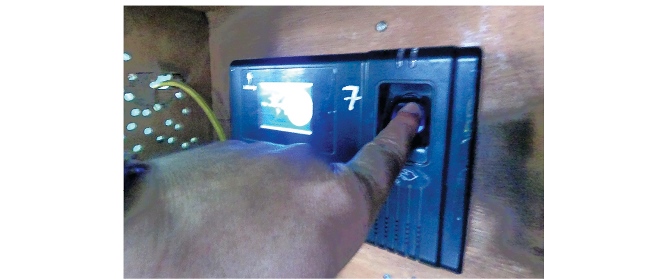Biometric fingerprint attendance machine may pose public health risk

By Aashish Mishra
Kathmandu, Mar. 17: The biometric fingerprint attendance machine was no short of a revolution for employee timekeeping when it was first introduced. It digitised the attendance system, reduced the chances of manipulation and made oversight a lot easier.
In Nepal too, the machine quickly found favour over the traditional paper-based signature systems and today, it can be seen hanging on the walls of offices all over the country.
But the small little box that transformed timekeeping and human resource management in our organisations may also be endangering our health. This is because a new study published in the database medRxiv, a pre-print server for Health Sciences operated by Cold Spring Harbour Laboratory, a research and educational institution, on Wednesday suggests that the coronavirus may survive on hard surfaces like stainless steel, plastic and glass for up to three days, especially alarming because the latter two materials are what the fingerprint machine is made of.
“People sneeze and cough into their palms or wipe their noses with their hands and when they put them on surfaces like desks or the attendance machine, it gets transferred there,” Sameer Mani Dixit, Director of Research at the Centre for Molecular Dynamics Nepal, told The Rising Nepal. “That opens the possibility for others to be infected when they place their hands/fingers there.”
He, however, added that a virus’ survival in an environment depended on a variety of factors and the study’s conclusion should not be taken to mean that the virus for COVID-19 always survives for three days on all hard surfaces. “However, as long as there is a possibility, care should be taken.”
So what may be the solution? Although the disease has not yet entered Nepal, what should we do if it ever does? According to Dixit, the answer is simple and relatively inexpensive, “Disinfect such surfaces that come into mass contact with sanitizer and bleach.”
His view is supported by another study published in February in The Journal of Hospital Infection, an independent scientific publication of the Healthcare Infection Society, UK, which publishes research and information relating to infection prevention and control. This study concluded that “coronaviruses, including the one causing the current outbreak, can be effectively wiped away by household disinfectants”.
But the best measure to avoid contamination, according to Dixit, is to regularly wash our hands for 20 to 30 seconds. “Washing our hands properly – including under the nails and in between our fingers – with soap and water is the best preventative measure, not only against COVID-19 but also against many other diseases,” he said, adding, “Hand washing is a good habit in general that should be practiced all the time, not only during outbreaks.”
In addition to the fingerprint attendance machine, other surfaces made of glass, plastic and steel like computer keyboards, tables, doors and windows and utensils may also pose a similar health risk.
Recent News

Do not make expressions casting dout on election: EC
14 Apr, 2022
CM Bhatta says may New Year 2079 BS inspire positive thinking
14 Apr, 2022
Three new cases, 44 recoveries in 24 hours
14 Apr, 2022
689 climbers of 84 teams so far acquire permits for climbing various peaks this spring season
14 Apr, 2022
How the rising cost of living crisis is impacting Nepal
14 Apr, 2022
US military confirms an interstellar meteor collided with Earth
14 Apr, 2022
Valneva Covid vaccine approved for use in UK
14 Apr, 2022
Chair Prachanda highlights need of unity among Maoist, Communist forces
14 Apr, 2022
Ranbir Kapoor and Alia Bhatt: Bollywood toasts star couple on wedding
14 Apr, 2022
President Bhandari confers decorations (Photo Feature)
14 Apr, 2022











